DURHAM - Blue Devil Nation's Patrick Cacchio sat down with Duke Offensive Coordinator Kurt Roper for an exclusive interview about the explosive Blue Devil offense led by second-year starting QB Sean Renfree.


DURHAM - Blue Devil Nation's Patrick Cacchio sat down with Duke Offensive Coordinator Kurt Roper for an exclusive interview about the explosive Blue Devil offense led by second-year starting QB Sean Renfree.
DURHAM - Blue Devil Nation caught up with Duke junior running back Desmond Scott at media day in Durham. After leading the Blue Devils in rushing his first two seasons, Scott is ready to take the next step and lead Duke back to a bowl game in 2011.
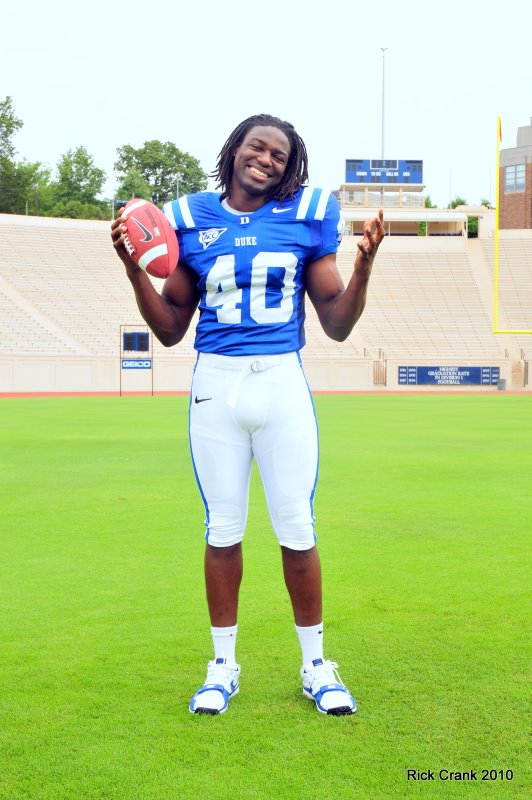
DURHAM - As we discussed yesterday, Duke's new 4-2-5 defensive scheme relies on the dynamic playmakers the Blue Devils have at safety, led by senior All-ACC candidate Matt Daniels. BDN spoke with Daniels at Duke Football's preseason media day about the upcoming season and his Duke career.
DURHAM - Blue Devil Nation was on hand for Duke Football's preseason media day and spoke with Defensive Coordinator Jim Knowles about the new-look Blue Devil defense. It's no secret that the Duke defense struggled in 2010, but Coach Knowles feels the new 4-2-5 scheme better fits the Duke personnel. Under the leadership of Matt Daniels and Charlie Hatcher, the defensive unit is working hard and improving every day in training camp.
Why the 4-2-5 Defense?
Since arriving at Duke in 2008, Coach David Cutcliffe has emphasized speed. One of his first comments on recruiting was, "We're going to start with people who can run." The 4-2-5 defense is flexible and emphasizes the use of speed. Simply stated, the defense removes a bigger player (linebacker) and replaces him with a faster player (safety). Of course it is actually a bit more complicated.
Football terminology can be confusing as the average fan attempts to determine exactly who are those linebackers named Mike, Will and Sam everyone keeps referring to and why the weak safety doesn’t spend more time in the weight room with the strong safety. Obviously, I’m just trying to be funny and probably not succeeding, but the point is I know how confusing the terminology can be due to the number of articles I read while preparing to draft this article.
Moving on…
Gary Patterson, the current head coach at Texas Christian University, and previous defensive coordinator at the University of New Mexico, has achieved much success with the 4-2-5 defense. In 2010, TCU finished the season 13-0 and defeated Wisconsin 21-19 in the Rose Bowl.
Patterson provides an in depth explanation of the 4-2-5 defense in this 1997 article written when he was the defensive coordinator at New Mexico.
The 4-2-5 Basics
The base defense uses eight men in the box to stop the run coupled with zone pass coverage such as the Cover 3. Achieving success with the 4-2-5 defense requires a team to commit to stopping the run first. Brian Billick explains the eight men in the box concept, on a white board with diagrams, in this video clip on You Tube.
Applying pressure via the blitz is the second objective. The defense is flexible and allows a team to bring pressure off the corners or inside without sacrificing pass coverage. The defense utilizes pressure to create turnovers.
Limiting big play opportunities is another feature. The use of five defensive backs makes it easier to disguise coverage and confuse the offense by showing blitz and zone coverage simultaneously.
Finally, the 4-2-5 attempts to force the offense to adjust to the defense. An offense that is adjusting is typically adjusting away from its strength. Influencing an offense to abandon its strength is a major accomplishment.
To summarize: stop the run, pressure the quarterback, do not give up big plays, and force the offense to adjust.
Cover 3 Zone
The spread offense is prevalent in today's college football landscape and the 4-2-5 in conjunction with the Cover 3 Zone is well suited to stopping the spread. Therefore, it is important to understand the principles of the Cover 3 Zone.
The Cover 3 Zone splits the top of the field into three deep zones, which frees up the strong safety to provide run support on the tight end side of the offense. The Cover 3 Zone provides the defense with an extra man in the box to stop the opponent’s running game.
Between five and 14 yards from the line of scrimmage, where receivers run outs, curls, hooks and slants, the two inside linebackers and the strong and weak safety provide coverage support. This underneath support allows the cornerbacks to focus upon any receiver who goes 14 yards beyond the line of scrimmage between the hash marks and the sideline with the free safety responsible for the middle of the field.
Let’s clarify each player’s pass coverage responsibility:
Cornerback (2): the deep outside from the hash marks to the sideline. The cornerback cannot allow a receiver to beat him on the outside because he receives no support in this area.
Free Safety: the deep middle between the hash marks and to provide inside support to the cornerbacks. The free safety must play as deep as the deepest pass route takes him.
Strong Safety: stopping the run and underneath pass coverage in the flats.
Weak Safety: stopping the run and underneath pass coverage in the flats.
Linebacker (2): stopping the run and underneath pass coverage in the hook/curl zones.
For more on the Cover 3 Zone, this article at the Clemson Tigers blog “Shakin’ The Southland” provides some nice details.
While the Cover 3 Zone is effective in conjunction with the 4-2-5, it is not the only option. The defensive package will contain lots of blitz options with those options mixing up the accompanying coverage assignments. Cornerbacks with the ability to play man-to-man really open up the 4-2-5 defense’s flexibility.
Blitz Packages
There are innumerous blitz opportunities in the 4-2-5 scheme with the inside blitz and double edge blitz being two examples.
To execute the inside blitz, the two linebackers blitz while the strong side defensive end (tight end side of the line) checks the tight end while executing a run/pass read, if the defensive end reads pass, he drops into middle coverage with primary responsibility for the tight end.
The inside blitz is strong against an inside run (between the tackles) or play action pass play, but it is vulnerable to a quarterback who sprints out of the pocket to the strong side.
When the double edge blitz is called, the weak and strong safeties blitz and the two linebackers takeover responsibility for pass coverage in the flats with the nose guard dropping into middle coverage after checking the center and executing a run/pass read. The vulnerability area for this blitz is the flats, while the strength is containing a mobile quarterback.
For more details, go here, for verbiage with diagrams. Ah, a picture is worth a thousand words.
Cover 2 Zone
The Cover 2 Zone is effective against Pro Set two running back offenses. In the Cover 2, the strong safety and free safety are each responsible for half the field deep. The cornerbacks are responsible for the flats, and typically play the wide receivers bump and run. The Cover 2 Man is another variant where the underneath defenders play man-to-man.
The linebackers are responsible for the hook/curl zones. The Cover 2 is strong against short routes and timing routes, but can be exploited by crossing routes or by sending two receivers deep on the same side of the field.
For a more detailed analysis of the Cover 2 Zone, I’ll once again refer the reader to the “Shakin The Southland” website and this article plus this You Tube video or this You Tube video featuring Bill Billick. I guarantee this is good stuff so be sure and click on the links.
Duke Specific Analysis
It is time to focus this article by discussing some Duke specific details. First, safety is the deepest position on Duke’s defensive roster, and Matt Daniels is the defensive leader so running a scheme which features the safety position passes the common sense test.
In 2010, Duke struggled to stop the run giving up 208 yards rushing per contest so a defense designed to stop the run first makes sense. The extra man in the box coupled with a blitz package oriented to stopping the run will prevent opponents from successfully running the ball straight up the middle play after play.
In 2010, Duke struggled to pressure the quarterback, recording only 12 sacks so a defense that includes multiple blitz packages and a commitment to applying pressure makes sense. Focusing upon pressuring the quarterback on pass plays will result in improved performance by the cornerbacks and free safety with the added benefit of increased interceptions.
Defensive Coordinator Jim Knowles possesses extensive knowledge and experience with the 4-2-5 so he will be able to teach the players how to execute the intricacies of the scheme.
The Blue Devils are poised to take a big step forward in the rebuilding process and that big step could include winning the requisite number of games to qualify for a bowl game. For Duke to become bowl eligible in 2011, the defense must step up and perform much better than they did in 2010.
To determine if the switch to the 4-2-5 defense is a successful move, fans need to view defensive statistics with a critical eye: rushing yards allowed, sacks by and turnover margin will be key indicators of whether or not the scheme is fulfilling expectations.
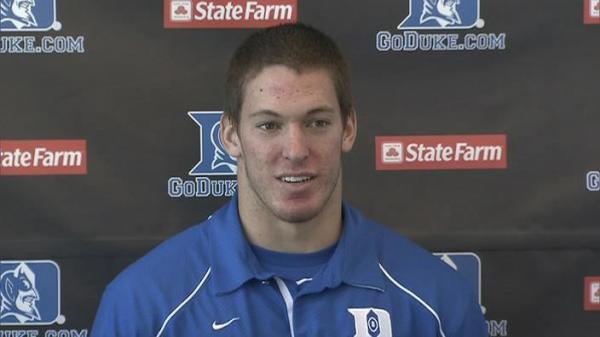
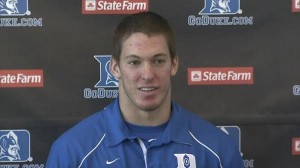
DURHAM- Blue Devil Nation was on hand for Duke Football's Media Day on Wednesday in Durham. One of the key players for the 2011 Blue Devils will be sophomore linebacker Kelby Brown, who has hit the field running this week after knee surgery late in 2010. BDN caught up with Kelby for an update on his health and the 2011 Duke defense.
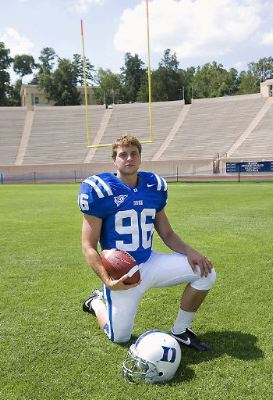
Prior to the arrival of Head Coach David Cutcliffe, Duke fans remember all too well the days of missed field goals (and extra points!!), botched snaps, muffed punts, and missed tackles. Duke’s special teams is now light years ahead of where it was just a few seasons ago, and should continue to improve and become a strength for the 2011 Blue Devils.
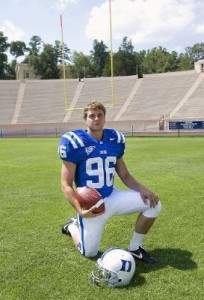
Kicking
Losses: Nick Maggio
Key returners: Will Snyderwine (R-Sr.), Paul Asack (R-Jr.)
Newcomers: none
2010 Review: Lou Groza semifinalist Will Snyderwine handled the kicking duties for the second straight season in 2010. After taking over for the injured Maggio in 2009, the former walk-on has now hit 38 of 44 (86.4%) field goal attempts in the past two seasons for the Blue Devils, with a career long of 52 yards at Georgia Tech in 2010. Snyderwine converted 32 extra points in 2010, extending his perfect career streak to 56/56. The combined field goal and extra point totals placed second all-time at Duke, with 95 points, and earned him All-American honors by the American Football Coaches Association, making him the first Blue Devil All-American kicker in school history. His value to the Duke team extended beyond field goals and extra points, as he increased his touchback numbers from 2/47 in 2009 to 11/60 in 2010. Charged to work on on-side kicks last offseason by Coach Cutcliffe, Snyderwine delivered, as the Blue Devils were able to recover 4 of 6 on-side kicks in 2010. Overall, the Duke kickoff unit ranked 3rd in the ACC and 18th in the country, allowing just 19.71 yards per return, with opponents average start at the 24 yard line.
2011 Outlook: Snyderwine returns to anchor the kicking game again in 2011, and has already garnered several preseason accolades, including the Lou Groza Award Watch List and several preseason All-American honors. The former walk-on has developed into a potent weapon for the Duke offense and special teams units. Snyderwine appears ready to cap off a historic career at Duke with a big senior season. With increased depth throughout the roster, the kick coverage should continue to improve and become a strength for the Blue Devils. Big plays occasionally haunted the Duke coverage unit, and they did give up one touchdown return on the season against Alabama. The only concern with the Duke kicking game in 2011 might be depth at kicker, where an injury to Snyderwine could significantly weaken the Blue Devils.
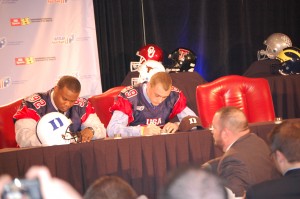
Punting
Losses: Kevin Jones
Key returners: Alex King (Sr.)
Newcomers: Will Monday (Fr.)
2010 Review: Jones lost the starting job to King after a botched punt against Wake Forest in 2010. King was mostly dependable for the Duke punting game, averaging 41.1 yards per punt, finishing 7th in the ACC. Of 55 punts on the year, King was able to pin opponents within the 20 yards line 21 times, with 6 touchbacks. The Blue Devils’ punters achieved a net of 33.6 yards per punt, which ranked 9th in the conference and 106th in the nation. The punt coverage, however, faired worse, allowing 14.4 yards per return, which ranked last in the conference and 117th in the nation. The Blue Devils were only able to force 7 fair catches on the season and allowed a punt return touchdown against Maryland.
2011 Outlook: Punting appeared to be the biggest weakness among Duke’s special teams unit in 2010, and stands to be an area of significant improvement in 2011. The hope is that with better depth, speed, and athleticism, the punt coverage unit will do a better job of limiting opponent returns. Punting should improve as well, as King now has nearly a full year of starting under his belt, and will be pushed by highly-touted freshman Will Monday. The competition between King and Monday will definitely be one to watch this month.
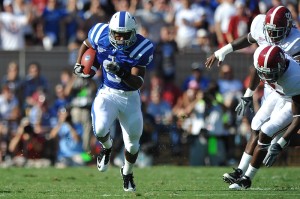
Kick Return
Losses: none
Key returners: Patrick Kurunuwe (R-Jr.), Desmond Scott (Jr.), Conner Vernon (Jr.), Josh Snead (So.), Juwan Thompson (So.)
Newcomers: TBD
2010 Review: Scott, Snead, and Thompson were the leading return men for the Blue Devils in 2010, and Duke ended the season 4th in the ACC with an average of 20.9 yards per return. As true freshmen, Snead and Thompson ranked 7th and 8th individually with averages of 22.0 and 21.7 yards, respectively. The Duke return game provided the offense with an average starting position of the 27 yard line.
2011 Outlook: Duke has yet to return a kickoff for a touchdown under Coach Cutcliffe. Will 2011 be the year? With the three primary return men all back, Duke seems poised to continue to use kick returns as a strength. Scott, Snead, and Thompson will continue to share carries in the Duke backfield, and will also split the kick return duties. With their combination of size, vision, and speed, it may be difficult for any newcomers to break into the rotation, but the Duke staff has shown a desire to rotate multiple return men in an effort to keep players fresh throughout the season. The kick return job is another key competition to watch during training camp.
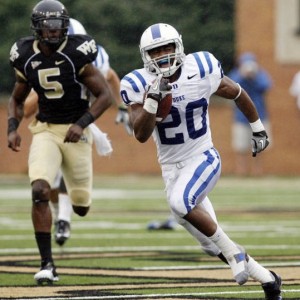
Punt return
Losses: none
Key returners: Lee Butler (Sr.), Johnny Williams (Sr.)
Newcomers: ?Jared Boyd (Fr.), ?Tim Burton (Fr.), ?Jamison Crowder (Fr.)
2010 Review: Butler handled the vast majority of punt return duties in 2010, finishing with a respectable 8.6 yards per return, which ranked 5th in the ACC and 31st in the nation. With a season long of 33 yards, Butler was able to consistently advance the ball, but rarely broke out for big returns. Williams showed some explosiveness as a punt returner in 2009, but due to injuries and a position change, only returned 2 punts in 2010.
2011 Outlook: With both Butler and Williams back, along with a group of speedy youngsters headed by Jamison Crowder, Duke appears ready to develop the punt return game into a significant weapon. There is likely to be significant competition for the starting job, and with some improved blocking, 2011 might be the year that fans see an explosive punt return game from the Blue Devils. Coach Cutcliffe has historically emphasized the kicking game in past training camps, and the punt return unit is likely to see significant reps this August.
BDN Duke Football 2011 Offense Preview
BDN Duke Football 2011 Defense Preview
Bookmark Blue Devil Nation for in-depth coverage of Duke Football all season long, from training camp through the 2011-2012 bowl season.
You must be logged in to post a comment.